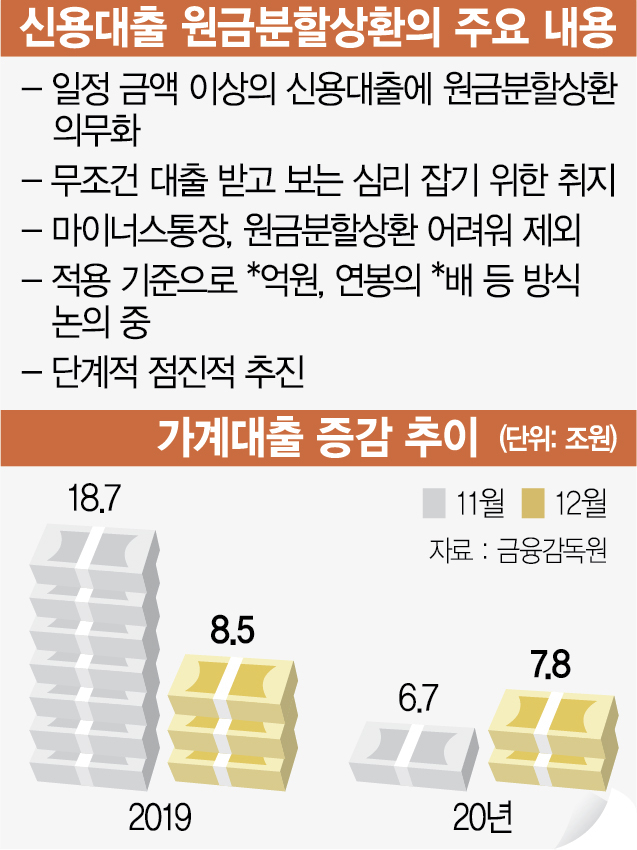[금융위 가계부채 관리 대책]
Loan surge at the beginning of the year increases debt concerns
Promote mandatory amortization like the main charge
DSR management method shifted to inspection by borrower
Concerns over demand for the last car before the release of the concrete plan
 viewer
viewer
The financial authorities decided to make it mandatory to repay in installments for large credit loans following mortgage loans. In order to put a brake on the recent surge in credit loans going to the stock market for investment purposes, the company has put more pressure after the limit on high credit loans. There are also concerns that demand for the last train will be rushing before specific measures come out in response to the authorities’ signals for the super strong credit loan regulation.
On the 19th, the Financial Services Commission announced the ‘2021 business plan’ containing these details. As one of the household debt management measures, the authorities have come up with a plan to oblige the amortization of the principal for credit loans exceeding a certain amount. Currently, credit loans only have to pay interest every month until their maturity, but if the installment payment method is applied, the burden of borrowers is inevitably increased as they must pay not only interest but also principal. An official from the Financial Services Commission explained, “If the principal split method is applied, demand for large credit loans may decrease,” and “detailed matters such as the amount and method applied should be reviewed.”
In addition, a plan to shorten the maturity period of credit loans is also considered. Usually, the term of a credit loan is one year, but most banks extend their maturity to a maximum of 10 years. The Financial Services Commission decided to reduce the maximum credit loan maturity period to 5 years as it judges that the 10-year period is long.
The reason why the Financial Services Commission pulled out a card with a strong credit loan regulation is due to the judgment that credit loans are expanding rapidly at the end of the year and into the stock market. Earlier, the Financial Services Commission issued a regulation on credit loans for high-income earners in November last year, blocking the way that credit loans flow into the asset market, and ordered banks to strengthen their credit loan management. Accordingly, the increase in bank credit loans declined to -44.4 billion won in one month from 4.84 trillion won in November last year. However, as banks resumed credit loans this year, credit loans surged KRW 453.3 billion in seven days this year.
However, it will not apply such measures to negative bankbooks. The negative bankbook is a form in which interest is charged only on the amount taken out of the limit whenever the borrower needs it, so the meaning of setting a limit when the principal is paid off disappears.
At the same time, the Financial Services Commission decided to switch the method of managing the total debt principal repayment ratio (DSR) by financial company to the repayment ability test by borrower unit. The plan is to manage household debt through the settlement of credit review, which focuses on repayment ability. Currently, the average value of each financial company only needs to be managed, so the DSR may exceed 40% for each borrower, but from now on, 40% will be applied to all borrowers at once. When principal installment repayment is introduced for large credit loans, the repayment of principal and interest increases, resulting in higher DSR for each borrower.
DSR is the ratio of the repayment amount of principal and interest of the total financial liabilities to the income of the borrower during the loan review process, and is an index to determine the repayment capacity of the borrower. It reflects the burden of principal and interest on loans in all financial sectors, including credit and card loans, as well as the main charge.
The Financial Services Commission plans to implement it in stages by differentiating the timing of implementation for each method. In addition, the policy is to manage from a long-term perspective so that the surge in household debt does not act as a burden on the economy. The goal is to reduce the current 8% household credit growth rate to 4-5%, which is the level of 2019 before the outbreak of Corona 19 in the next two to three years. Chairman Eun said, “We will reduce the scale of household debt growth, but manage it to an appropriate level under a long-term clock to promote a soft landing.”
/ Reporter Lee Ji-yoon [email protected]
< 저작권자 ⓒ 서울경제, 무단 전재 및 재배포 금지 >
